2022 Hotel Industry Design Trends
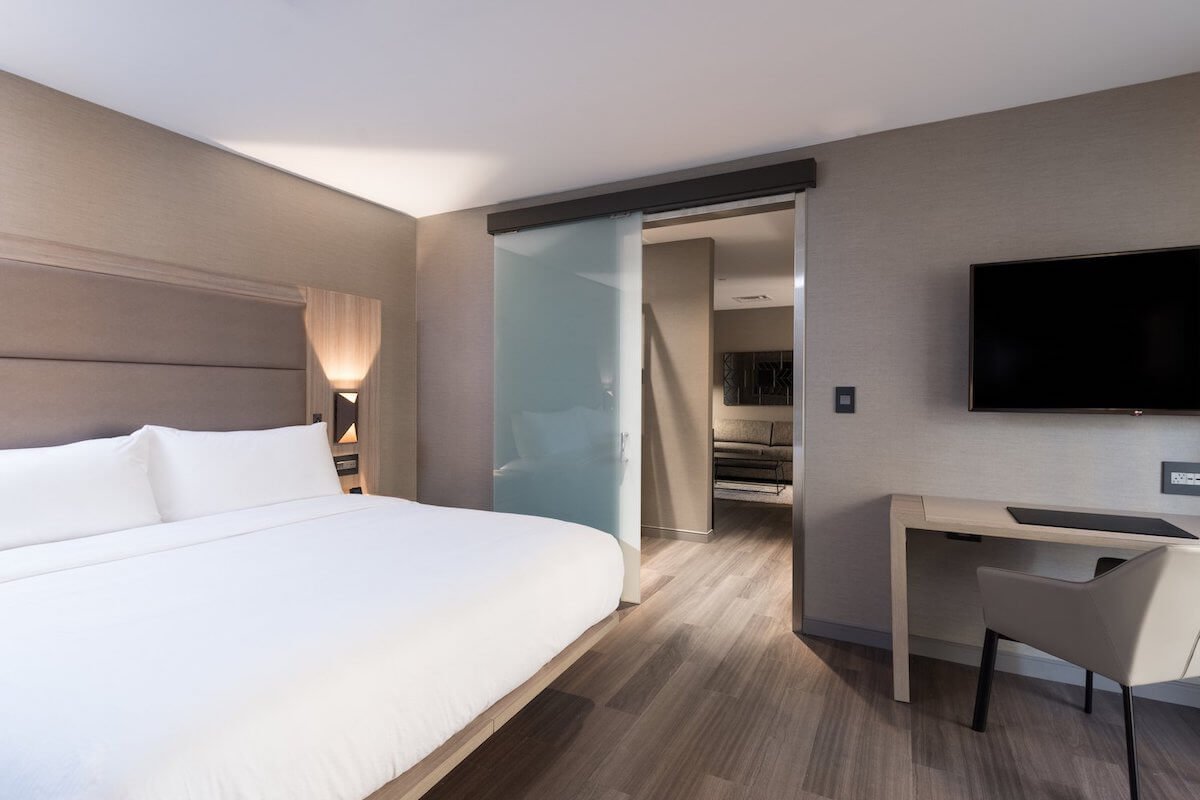
As the travel and hospitality industries rebound in 2022, keeping up with the latest designs trend is more important than ever. Now, hotels must look to not only differentiate themselves from the competition but also attract customers in a safe and welcoming way — and everything is fair game.
Amenities, services and, most importantly, design choices are all pivotal decisions hotels have to make to bring in customers and earn repeat business.
When looking at current hotel design trends, many try to create a more inviting space that elicits the feeling of a “home away from home.” Fostering that comfortable, relaxing — and also safe — atmosphere leaves guests with a positive opinion of the hotel, and one they might share in reviews or with their friends or family.
Many hotels even design with social media in mind, installing eye-catching features or greenery that might inspire guests to snap a photo to share. Below are some of the exciting trends we’re seeing in the hotel industry that you should consider in your next design.
Comforting, Home-Like Atmosphere
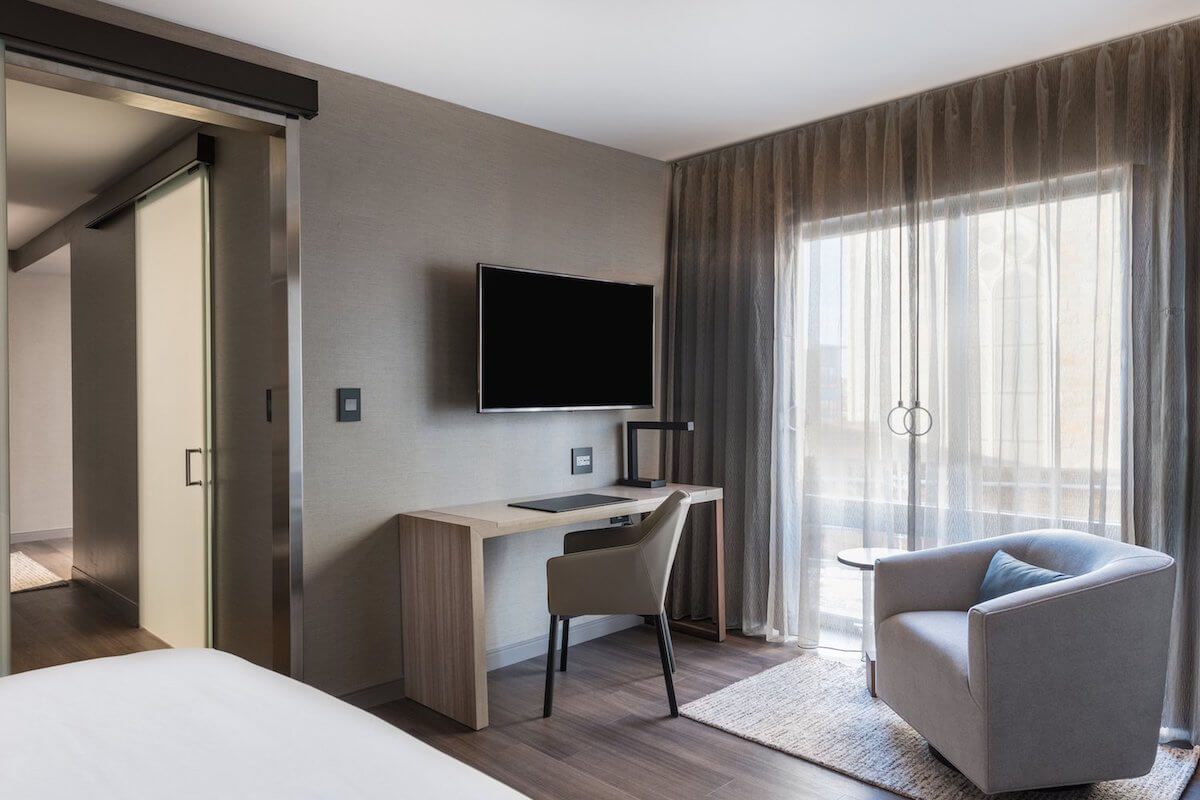
Many hotels are incorporating the comfortable, inviting design elements of a residential home into their commercial space. This hotel design trend is especially important for guest rooms, where you want to create an environment that feels safe and relaxing — whether a person is traveling for business or pleasure. It is equally important in outdoor spaces since many guests are often looking to enjoy refreshments on a balcony or relax before their next meeting.
Plus, helping guests feel comfortable and relaxed is a great way to leave them with a favorable impression of the hotel space and brand.
“Hotel guests are looking for designs that are comfortable and approachable, which is a shift from past decades,” said Charlotte Blue, Interior Designer at LS3P. “Fireplace lounges and outdoor spaces where business travelers can feel comfortable checking email on their devices have become an industry standard.”
This type of aesthetic can be accomplished with certain floor and wall options, namely accent walls and eclectic flooring. Rustic-looking LVT, for example, is a popular design element that can be used for accent walls to add dimension and warmth to a room.
Functional Lobbies
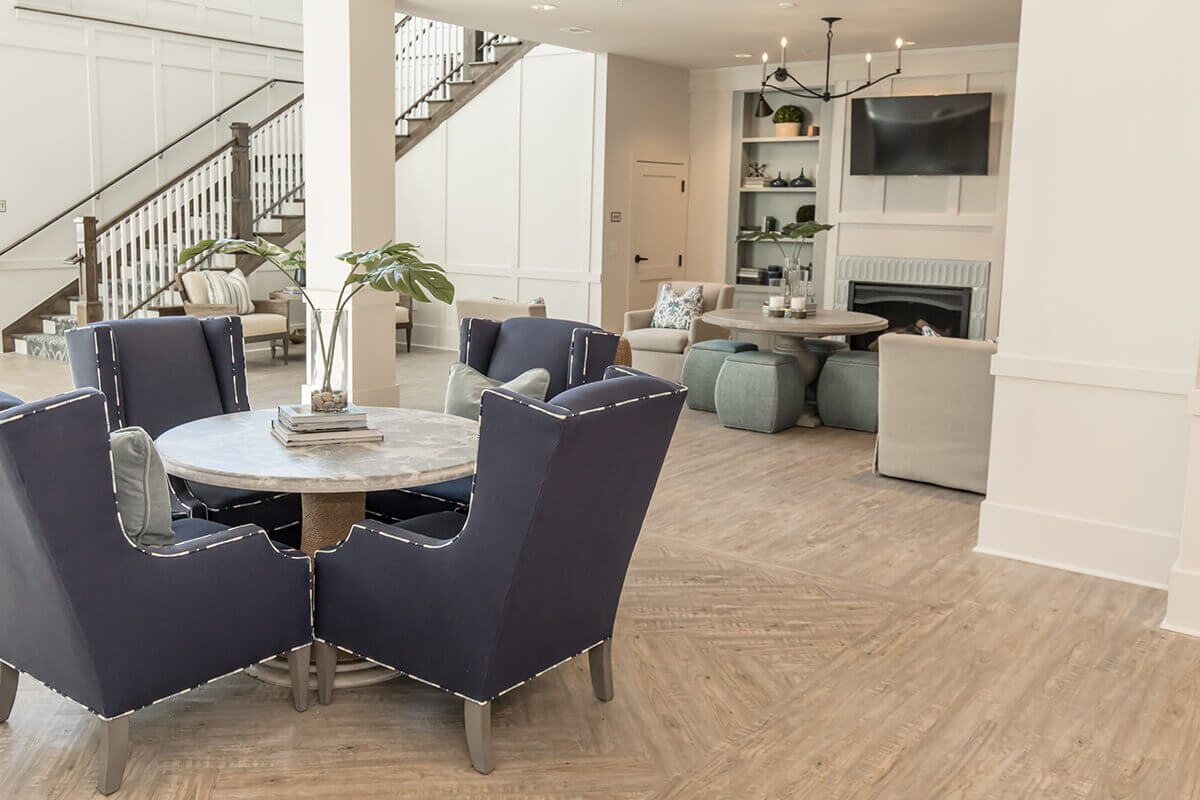
Lobbies have typically served one purpose: as a place to check in to your room and to get information from the front desk. Décor was minimal, with an occasional couch and side table set up for guests. Over the years, however, lobbies have elevated their design aesthetic and been transformed to better serve and engage all guests.
Now, for an added level of safety and security, many hotels are incorporating sanitation stations, digital check-in methods and touchless features such as elevator keypads and credit card machines to give guests peace of mind.
But as more people begin to feel comfortable congregating in lobbies, hotels will once again turn to design and style to ensure a welcoming, relaxing atmosphere. Comfortable chairs and sofas, eye-catching plants and artwork, and stylish rugs and furnishings are the perfect addition.
“Hotel lobbies are the ultimate gathering space for guests and locals alike, and their inviting atmosphere and comfortable setup draw guests into spending time in the space beyond their initial check-in/checkout,” said Giovanna Lucy, Interior and Merchandising Designer who worked on the Nantucket-based Hotel Pippa remodel. “At Hotel Pippa, we really wanted our guests to feel at home as soon as they step into the building, so we incorporated a fireplace into the lobby, striking art by local artist Nathan Coe, and curated music playlists to set the mood.”
Whether it’s work or play, new hotel design trends are seeing lobbies that cater to all needs. Many are equipped with coworking spaces, which is especially important with the increase in remote employees. Guests have a place to make calls, charge their phone or use their laptop while enjoying access to free Wi-Fi.
Even if guests aren’t there for work, having a designated space to check in with family and friends back home or just relax outside of the room has become a vital design element for hotel lobbies.
Improved Amenities
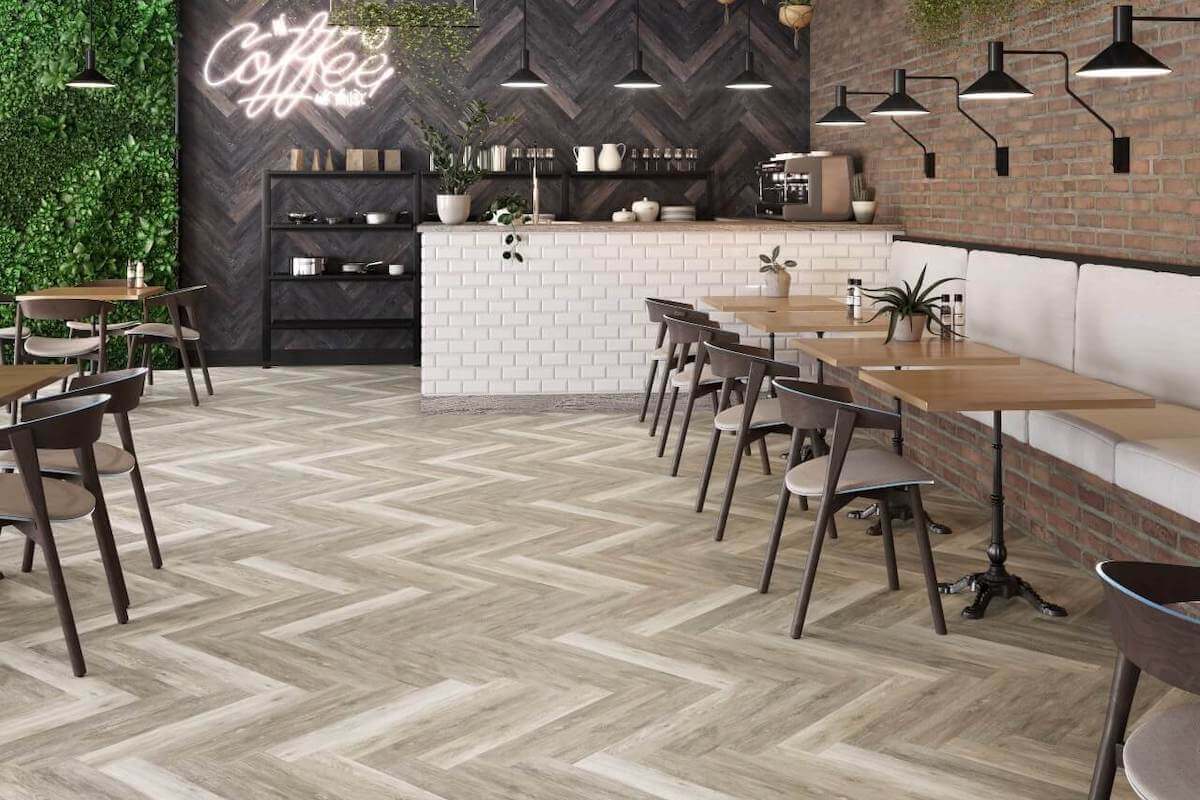
Of course, there is usually more to hotels than just guest rooms and lobbies. Hotel management teams want to find ways to keep their patrons within their four walls, and offering improved amenities is a good way to do that.
A restaurant, bar or café is always a popular option. A frequent tactic is to lease the hotel’s restaurant space to a third party. This takes the economic burden off the hotel and provides a convenient dining option for guests. To keep guests safe, many restaurants have installed partitions or decorative dividers; some are even turning to QR codes so patrons can easily access the menu from their phones.
A hotel can also be an alternative to the office. Many workers are turning to hotels, cafés and bars instead, especially if they’re seeking a corporate environment but don’t yet feel comfortable (or even need to) return to their workspace. Since remote work doesn’t necessarily mean working from home, hotels are a viable option if an employee is looking for a change of scenery or wants to put in a few hours while on an extended family vacation.
Other ideas include amenities designed to improve physical and mental wellness, such as yoga studios, fitness centers and spa/massage rooms. Commercial wallcoverings and accent walls are easy ways to provide interest and style to any of these spaces.
Wood and Wood-Look Flooring
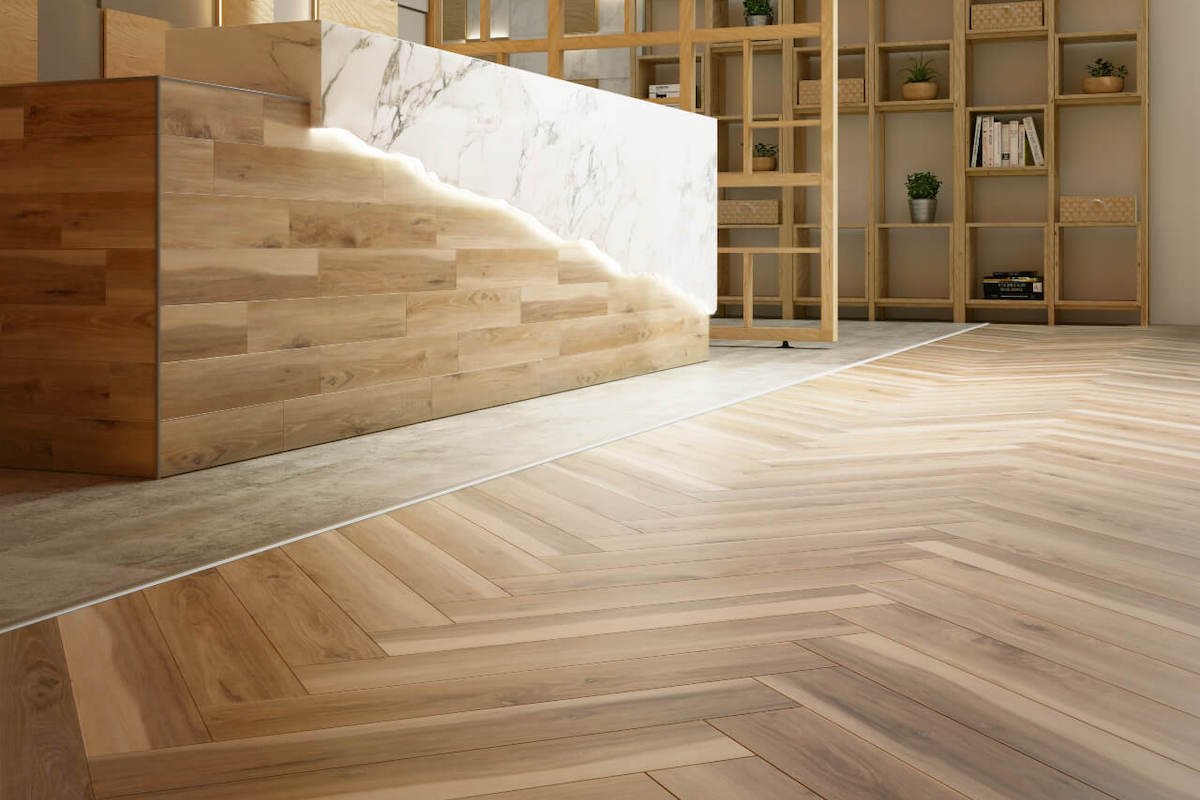
More and more, we are seeing designers incorporate wood and wood-look flooring products in hospitality spaces.
Choose natural, rustic wood for a timeless, sophisticated solution in the lobby and opt for complementary wood-look LVT for guest rooms. Not only does wood and wood-look LVT come in a variety of colors to match any design aesthetic, but both are extremely durable flooring options — perfect for hotels.
Certain types of LVT also feature a specialized backing for sound absorption, which is ideal for privacy and quiet desired by most hotel guests.
“Hard surfaces such as tile or LVT have become the ideal material in the guestroom for multiple reasons: The durability and life cycle is better, meaning higher installation costs but lower costs over time. Also, the cleanability of these materials is preferred by hotel guests, along with hotel operations staff,” added Blue.
LVT is also a great option for other areas of the hotel like restaurants, cafés and hallways, where designers want to continue their design pallet.
More Robust Technology
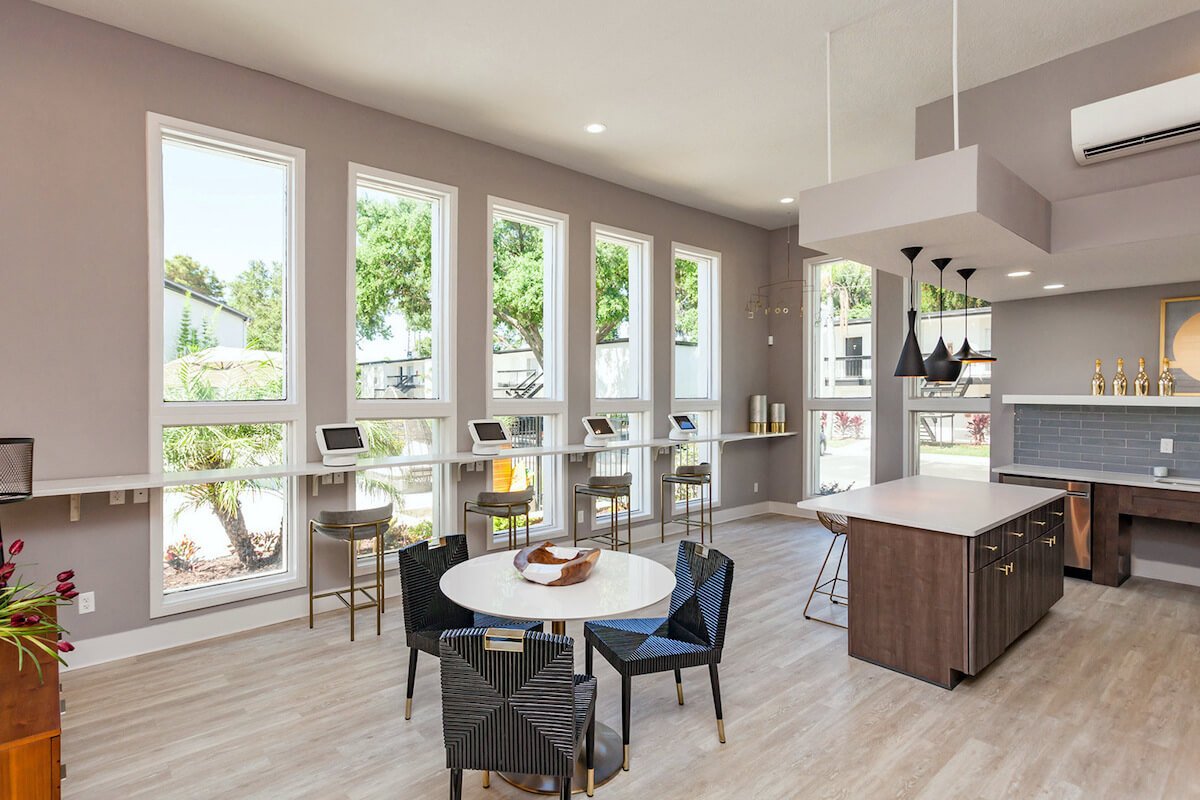
Coworking spaces are continuing to pop up in hotels, and with that comes more technology. Increased Wi-Fi capacity, more outlets available to plug in devices and other tech capabilities are now a necessity for hotels.
As the use of technology increases, some hotels are incorporating iPads for people to check in on instead of having to wait in line and check in at a desk. Tablets are also a feature in the guest rooms, so people can learn more about the local area and explore options. Keyless room entry with smartphone apps, USB ports in rooms and lobbies and automated check-in and check-out capabilities are some additional examples. This is just the tip of the iceberg for technology in hotel design trends.
Some hotels have even turned to robotics to improve the guest experience and hotel operations. “Each stage of a guest’s stay is somehow influenced by technology to create a more efficient experience,” said Emma Petty, Social Media & PR Executive for YOTEL. “Our robot crew can assist with the smooth running of the hotel, our New York city hotel features a robotic concierge and our hotels in Singapore, Miami and Boston have robots that deliver amenities to guests’ rooms as well as assisting housekeeping in the daily delivery of their tasks.”
Designing for Minimal Square Footage
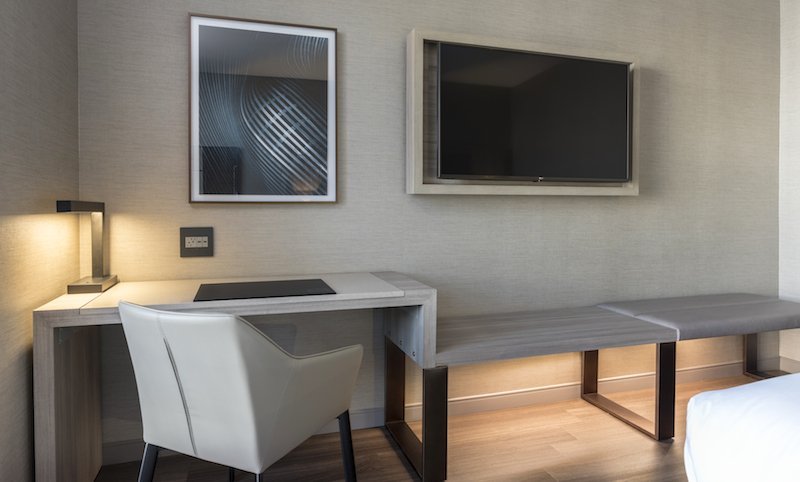
Some hotels are proving that bigger is not always better. In large cities where square footage is hard to come by, hotels naturally have less space to work with. Especially in guest rooms, designing to make the most of the space is the new frontier for hotels. “It’s all about finding ways to leverage the smaller spaces for functionality and creating the missing comforts,” said Lucy.
To open up more room, designers and hotels have started to change the idea of what a hotel room layout should be. “We see combining work surface, dining, and lounging into one,” said Bessie Shen, Senior Designer at KNA Design. “For example, in a guestroom, the lounge seating will have one continental or dining height table that acts as all three functions, and the use of millwork or case pieces that incorporate closets, dressers, and amenities for the room in one condensed unit is incredibly popular.”
This trend goes even further, with some opting to add a hanging clothing rack to the wall. TVs are sometimes mounted to walls instead of being placed on a desk or dresser, saving valuable floor space in cramped quarters. We are even seeing lofted beds with seating underneath, to give the room a larger feel despite being small in terms of square footage.
But the idea of minimal square footage also goes beyond the idea of small city hotels. It now includes boutique hostels, Airbnb rentals or even your own backyard. For example, Hipcamp is an online platform that allows outdoor enthusiasts a safe (and legal) way to enjoy Mother Nature on someone else’s private property. In addition to thousands of acres of properties, you can rent space in rustic cabins, “glamping tents” and vacation rentals.
Themed Rooms and Hotels
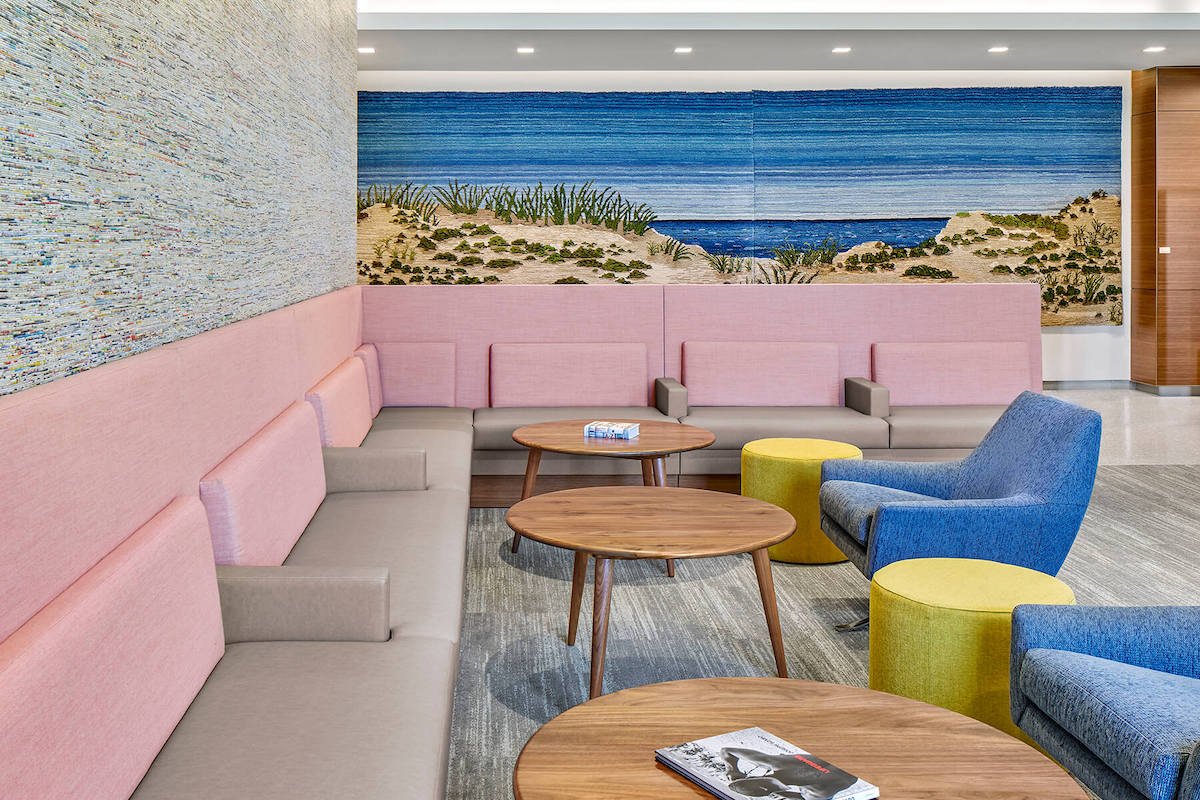
Many guests are seeking not just a place to sleep but an engaging, picture-worthy hotel experience — and that’s where the beauty of themed suites and hotels comes in. For example, Adventure Suites in North Conway, New Hampshire offers themed rooms that include a jungle safari, movie theater, deserted island, haunted castle, treehouse and wine cellar.
21c Museum Hotel functions, as the name implies, as both an art museum and hotel — with multiple locations across the country. The Verb Hotel, located in Boston, is a “music-inspired boutique hotel experience offering a retro-chic vibe with rock and roll artifacts and collectibles everywhere you look.”
At Winvian Farm, you can stay in a fully restored Pelican helicopter or a sophisticated treehouse 35 feet above the ground. Press Hotel in Portland, Maine, once home to the Portland Press Herald, pays homage to the past with a newspaper theme.
Sustainability
There’s been a big push for sustainability across many industries — and hospitality is no exception. Some eco-friendly ideas include installing water bottle refilling stations in the lobby (or on multiple floors) and adding signs in rooms to encourage bath towel reuse. Keyless entry reduces the need for plastic cards and automated lighting and room sensors can help reduce energy consumption.
According to Pinnacle Advisory Group, LEED certification is also a growing trend among hotel developers. LEED — also known as Leadership in Energy and Environmental Design — “is the most widely used green building rating system in the world,” as explained by the U.S. Green Building Council.
From sustainable flooring and other eco-friendly building materials to installing green walls and encouraging environmental-friendly energy practices, there are plenty of options to incorporate sustainability into any hotel design or renovation.
All of the hotel trends seen so far this year have one goal in mind – giving guests a complete, safe and enjoyable experience they will remember. No matter what trends you incorporate or design choices you make, everything starts from the bottom up. When looking for flooring for your next hotel space, look no further than LVT or engineered hardwood from Parterre. Our beautiful design options fit any palette and are crafted with quality in mind. Contact one of our representatives today to learn more.
Roche FitzGerald
Roche FitzGerald, Lead Product Designer for Parterre, is a second-generation artisitc giant in the flooring industry developing an appreciation for art and physical composition from his father, who was also an artist and leader in surface design.
“The mindset I have when creating art is that accidents are beautiful, which is something my father instilled in me,” said Roche. “There is an allure to discovering organic textures, patterns, and colors.”
A true artist at heart, Roche shapes designs from his own paintings or the inspirations of daily life. In the early 2000s, while other companies were turning to their manufacturers for options, Roche led the way in producing original flooring designs earning multiple industry awards and recognition for his luxury vinyl designs.
Polished Concrete vs. Vinyl Flooring
Polished Concrete vs. Vinyl Flooring Polished concrete vs. vinyl flooring. It’s not an easy decision, considering both provide an excellent solution for commercial flooring. The look of concrete floors has been a growing trend for commercial interiors.
Chevron and Herringbone
Break the Pattern of Commercial Flooring You can add more flair to your commercial flooring by breaking from the look of traditional straight-line, square, and diagonal patterns. Eye-catching looks like chevron and herringbone will dot the designer landscape in 2024.